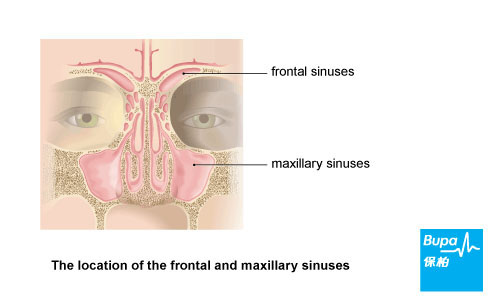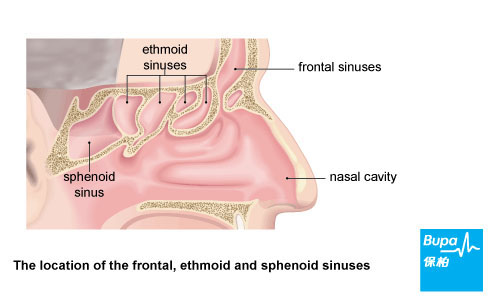Sinusitis is an infection or inflammation of the membranes that line the nasal passages and sinuses, the air-filled spaces at the front of the skull. Most colds – infection with one of the common cold viruses – cause a stuffy or bunged up nose, which clears up within a few days. But if the sinuses become inflamed, other symptoms such as headache and painful swelling of the face may develop.
Types of sinusitis
The sinuses are hollow air-filled spaces in the skull bones. They're connected to the nose and lined with the same membrane, called mucous membrane, which produces a slimy secretion (mucus) to keep the passageways moist and trap dirt particles. There are four main sets of sinuses. The frontal sinuses are on either side of the forehead above the eyes. The maxillary sinuses are in each cheekbone. The smaller ethmoid sinuses are behind the bridge of the nose and between the eyes, and the sphenoids are between the upper part of the nose and behind the eyes.


Sinusitis may only last a few days (acute sinusitis), or it may be an ongoing problem that, without treatment, never completely goes away (chronic sinusitis). Acute sinusitis is common, chronic sinusitis is less common. Babies under one don't get sinusitis because their sinuses are not fully developed, but it can otherwise affect people of any age.
Causes of sinusitis
Most cold viruses only result in a blocked nose. However, if the mucous membrane lining the nasal passages and sinuses swells up, this can block off mucus drainage holes. Mucus builds up behind the blockage causing the pressure and pain of sinusitis. Bacteria or fungi are more likely to grow in sinuses that can't drain properly, and bacterial infection often causes more inflammation and pain.
Chronic sinusitis is caused by anything that irritates the lining of the nose over long periods and causes the mucous membrane to swell. Examples include:
Chronic sinusitis is caused by anything that irritates the lining of the nose over long periods and causes the mucous membrane to swell. Examples include:
- grass and tree pollen
- cold air
- alcohol
- perfumes
- damp weather
- allergy to house dust mite, mould and fungi
Symptoms of sinusitis
The main symptom of sinusitis is a throbbing pain and pressure in the face, which is made worse by bending forwards. Frontal sinusitis causes pain over the forehead above the eyebrows, which may be tender to touch. Maxillary sinusitis causes aching in the upper jaw, teeth and cheeks which may be mistaken for toothache.
Inflammation of the ethmoid sinuses causes pain around and between the eyes and the sides of the nose. Inflammation of the sphenoid sinus can cause earache, neck pain or an ache behind the eyes, at the top of the head or in the temples.
Other typical symptoms include:
Inflammation of the ethmoid sinuses causes pain around and between the eyes and the sides of the nose. Inflammation of the sphenoid sinus can cause earache, neck pain or an ache behind the eyes, at the top of the head or in the temples.
Other typical symptoms include:
- return of a stuffy nose after a cold has cleared up
- thick yellow or green discharge from the nostrils
- cold symptoms that don't respond to treatment
- foul smell in the nose
Diagnosis of sinusitis
The doctor will ask about symptoms, touch parts of the face to find any pain or swelling, and may use a technique called transillumination, where a bright light is held against the cheek or forehead in a dark room. The light should pass through normal sinuses; if it doesn't, this suggests a blockage.
If the symptoms and physical findings are typical of sinusitis, no further testing is usually needed. If there's any doubt, the doctor may recommend X-rays, magnetic resonance imaging (MRI) or computerised tomography (CT). Nasal endoscopy may be used to investigate chronic sinusitis. A flexible telescope with a light on the end is inserted into the nostril to examine the inside of the sinuses. This test is usually done under local anaesthetic.
If the symptoms and physical findings are typical of sinusitis, no further testing is usually needed. If there's any doubt, the doctor may recommend X-rays, magnetic resonance imaging (MRI) or computerised tomography (CT). Nasal endoscopy may be used to investigate chronic sinusitis. A flexible telescope with a light on the end is inserted into the nostril to examine the inside of the sinuses. This test is usually done under local anaesthetic.
Treatment of sinusitis
Acute sinusitis
Often sinusitis can be treated with home treatments. Rest, inhalation of steam from a bowl of hot water, and over the counter medicines should help. A pharmacist will be able to advise you on a suitable choice. Ibuprofen or paracetamol help to relieve pain and lower temperature. Decongestants, such as pseudoephedrine (tablets or linctus, e.g Sudafed tablets), and menthol, which can be inhaled, reduce the swelling in the nose and allow the sinuses to drain. Decongestants should not be used for more than a week, as prolonged use can actually aggravate nasal blockage.
A doctor should be consulted if symptoms don’t improve after a week of trying home remedies. The doctor will probably prescribe a course of antibiotics for 3-10 days.
Chronic sinusitis
Steroid nasal sprays (e.g. beclometasone Beconase), available from pharmacists and on prescription, are helpful in two ways. If long-term infection is present they help to reduce swelling of the nasal lining and open up the drainage holes, and if allergy is involved they also reduce inflammation. Antihistamines such as loratidine (Clarityn) might also help. In severe cases, the doctor may recommend short courses of steroid tablets. These are only available on prescription.
Endoscopic nasal surgery may be needed as a last resort. Tubes and instruments passed down the nasal endoscope are used to wash out the sinus and widen the drainage hole. This can be done under general or local anaesthetic. It is a routine and generally safe procedure, but all surgery does carry some element of risk. Complications include minor damage to the lining of the nose or sinuses, or damage to the skull bone. Other types of surgery sometimes required to treat chronic sinusitis include correcting a bent nasal cartilage (septoplasty) or removing nasal polyps."
Often sinusitis can be treated with home treatments. Rest, inhalation of steam from a bowl of hot water, and over the counter medicines should help. A pharmacist will be able to advise you on a suitable choice. Ibuprofen or paracetamol help to relieve pain and lower temperature. Decongestants, such as pseudoephedrine (tablets or linctus, e.g Sudafed tablets), and menthol, which can be inhaled, reduce the swelling in the nose and allow the sinuses to drain. Decongestants should not be used for more than a week, as prolonged use can actually aggravate nasal blockage.
A doctor should be consulted if symptoms don’t improve after a week of trying home remedies. The doctor will probably prescribe a course of antibiotics for 3-10 days.
Chronic sinusitis
Steroid nasal sprays (e.g. beclometasone Beconase), available from pharmacists and on prescription, are helpful in two ways. If long-term infection is present they help to reduce swelling of the nasal lining and open up the drainage holes, and if allergy is involved they also reduce inflammation. Antihistamines such as loratidine (Clarityn) might also help. In severe cases, the doctor may recommend short courses of steroid tablets. These are only available on prescription.
Endoscopic nasal surgery may be needed as a last resort. Tubes and instruments passed down the nasal endoscope are used to wash out the sinus and widen the drainage hole. This can be done under general or local anaesthetic. It is a routine and generally safe procedure, but all surgery does carry some element of risk. Complications include minor damage to the lining of the nose or sinuses, or damage to the skull bone. Other types of surgery sometimes required to treat chronic sinusitis include correcting a bent nasal cartilage (septoplasty) or removing nasal polyps."
Prevention of sinusitis
It is possible to reduce the chances of developing sinusitis. Here are some things that might be helpful, especially for people who are prone to sinusitis:
- keeping the air humid at home
- using an air-filtering vacuum cleaner
- removing pets
- having a course of anti-allergy injections
- stopping smoking
- drinking less alcohol
- using a decongestant spray or tablets before diving or swimming
Disclaimer
This information was published by Bupa Group's Health Content Team and has been reviewed by appropriate medical or clinical professionals. To the best of their knowledge the information is current and based on reputable sources of medical evidence, however Bupa (Asia) Limited makes no representation or warranty as to the completeness or accuracy of the Content.
The information on this page, and any information on third party websites referred to on this page, is provided as a guide only. It should not be relied upon as a substitute for professional medical advice, nor is it intended to be used for medical diagnosis or treatment. Bupa (Asia) Limited is not liable for any loss or damage you suffer arising out of the use of, or reliance on, the information.
Third party websites are not owned or controlled by Bupa and any individual may be able to access and post messages on them. Bupa is not responsible for the content or availability of these third party websites. Last updated August 2017.
The information on this page, and any information on third party websites referred to on this page, is provided as a guide only. It should not be relied upon as a substitute for professional medical advice, nor is it intended to be used for medical diagnosis or treatment. Bupa (Asia) Limited is not liable for any loss or damage you suffer arising out of the use of, or reliance on, the information.
Third party websites are not owned or controlled by Bupa and any individual may be able to access and post messages on them. Bupa is not responsible for the content or availability of these third party websites. Last updated August 2017.









